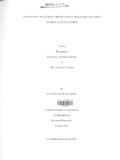| dc.description.abstract | Kenya like most other developing countries has been reforming her staple grain
markets since 1986. In these sectors, market reforms were initiated as a key
component of the economy-wide structural adjustment programmes (SAPs). The
SAPs were later strengthened and made irreversible by Kenya’s commitments at the
multilateral trade negotiations. The reforms were envisaged to improve the sectors
terms of trade as a means of stimulating food production. However, the impacts of
trade reforms on Kenya’s maize sector remain controversial. Thus, there is need for
empirical research to inform government interventions in this sector.
This study evaluates the impacts of trade liberalization and their distributional effects
on stakeholders in Kenya’s maize sector. Specifically, the objectives are threefold: to
assess the price responsiveness of producers, wholesalers and consumers, to quantify
the market and welfare impacts of trade liberalization and to draw policy
recommendations. The study uses recent developments in time series econometrics
based on cointegration techniques and error correction models (ECM) to estimate
price responses. To quantify the impacts of trade liberalization, a partial equilibrium
model (PEM), which accounts for market interrelationships at the farm, wholesale and
retail levels is developed.
The elasticities of supply and demand were estimated using annual cereal production
and consumption data for the period 1963-2005 from Kenya’s statistical office. In all
cases, the estimated models performed well on theoretical and statistical grounds. All
own-price elasticities had the expected signs and were statistically significant. On the
basis of the Marshallian elasticities, cereals can be considered as necessities in Kenya.
All long-run own-price acreage elasticities were elastic. Similarly, the long-run ownprice
elasticities at the intermediate level were elastic. The elastic price responses
imply that cereal producer responses in Kenya are quite high, suggesting a significant
potential for the sector’s response to trade liberalization.
The results from the trade policy simulations suggest that tariff reductions yield price
decreases across the three market levels. The declining prices increase maize
consumption but reduce domestic production. Consequently, consumer surplus
increases while producer surplus decreases. However, the gain in consumer surplus is
not sufficient to compensate the loss in producer surplus. Thus, Kenya’s
implementation of the Uruguay Round trade liberalization commitments leaves the
maize sector worse off. Any further tariff reductions without compensating maize
producers cannot be recommended based on the compensation principle. | en |

